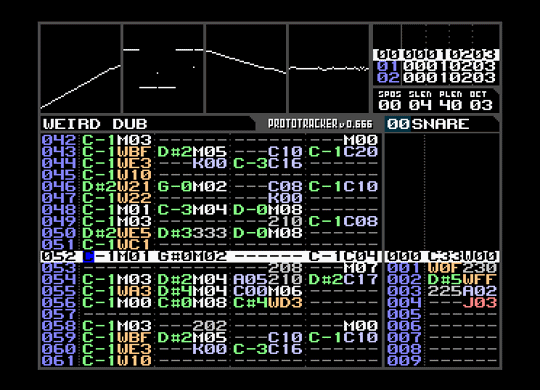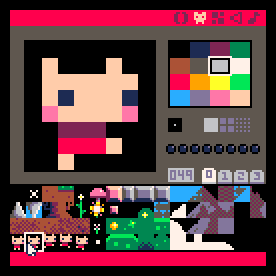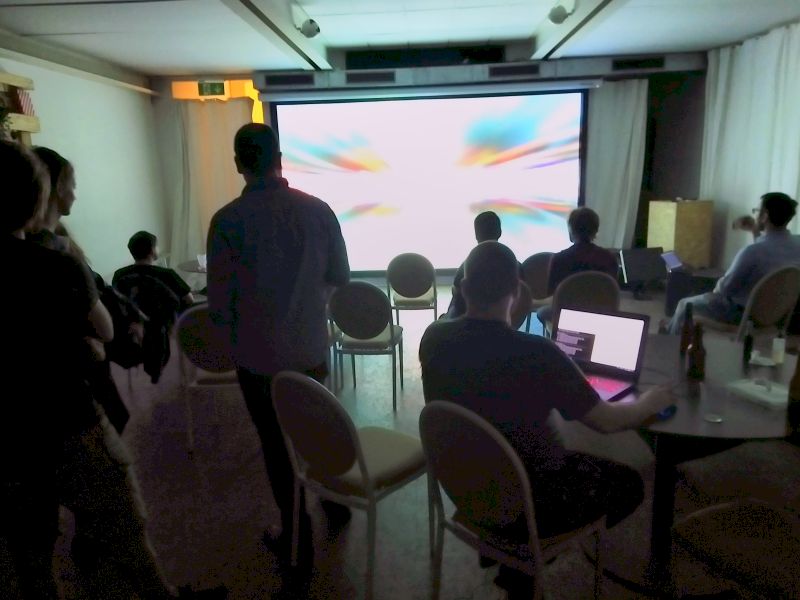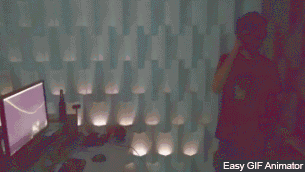![]() Next Friday another Echtzeit Digitale Kultur - Swiss demoscene club - event will be hosted @ EffingerBern, and this time we are planning to start a bit early and spend some time doing some „open development“, working for a couple of hours on creative projects. In case you are wondering: there will be no lecturing or presentations, just peer-to-peer knowledge exchange in this workshop. And once we have made some generative art, it’s partytime! Details and sign up here:
Next Friday another Echtzeit Digitale Kultur - Swiss demoscene club - event will be hosted @ EffingerBern, and this time we are planning to start a bit early and spend some time doing some „open development“, working for a couple of hours on creative projects. In case you are wondering: there will be no lecturing or presentations, just peer-to-peer knowledge exchange in this workshop. And once we have made some generative art, it’s partytime! Details and sign up here:
https://www.effinger.ch/events/100202/
![]() Have a look at what people came up with at the last Demonights which featured a One Effect Competition: Demonights 004 - Demozoo For a general introduction, see my 010 post or the even more informative demoscene.info. Find out here what kind of tools are useful/fun to learn for making some trippy real-time movies.
Have a look at what people came up with at the last Demonights which featured a One Effect Competition: Demonights 004 - Demozoo For a general introduction, see my 010 post or the even more informative demoscene.info. Find out here what kind of tools are useful/fun to learn for making some trippy real-time movies.
![]() For complete beginners, start with screensavers. Tune in to your favourite source of streaming music (e.g.:
For complete beginners, start with screensavers. Tune in to your favourite source of streaming music (e.g.: ![]() Nectarine
Nectarine ![]() ), and fire up one of these trippy music visualizers to get a taste for generative art coding: Synesthesia, Plane9, Morphyre, FLAM3 (on which Electric Sheep is based on). Then visit Demozoo, Pouët, or TheDemoTube to discover the art of the demoscene.
), and fire up one of these trippy music visualizers to get a taste for generative art coding: Synesthesia, Plane9, Morphyre, FLAM3 (on which Electric Sheep is based on). Then visit Demozoo, Pouët, or TheDemoTube to discover the art of the demoscene.

![]() The magic can start when you got a good beat. You can make music with popular apps like Soundtrap or scene utils like 64klang. Generating sounds with binaural beats could be trippy, as is doing some DJaying with ccmixter or sampleswap. It’s not really my specialty, so I’m probably just going to cruise over to the scenemusic archive of open sounds and find something with a decent beat. Then again, we will have a MIDI keyboard so get tracking!
The magic can start when you got a good beat. You can make music with popular apps like Soundtrap or scene utils like 64klang. Generating sounds with binaural beats could be trippy, as is doing some DJaying with ccmixter or sampleswap. It’s not really my specialty, so I’m probably just going to cruise over to the scenemusic archive of open sounds and find something with a decent beat. Then again, we will have a MIDI keyboard so get tracking!

![]() In a similar vein, you can make graphics online using make8bitart or vectr and there are thousands of desktop programs. I’m in a VR mood these days so I’d love to play some more with Tilt Brush and Sketchbox, though a LEAP motion or plain old mouse and keyboard make SculptGL and Blender practical for most modelling needs. MagicaVoxel (pictured above) would be very fun to play with.
In a similar vein, you can make graphics online using make8bitart or vectr and there are thousands of desktop programs. I’m in a VR mood these days so I’d love to play some more with Tilt Brush and Sketchbox, though a LEAP motion or plain old mouse and keyboard make SculptGL and Blender practical for most modelling needs. MagicaVoxel (pictured above) would be very fun to play with.
![]() For making animations, we could look at pro tools like Creature and Notch Builder, or have fun with vvvv and frame.js. There are loads of animation makers and visual coding interfaces. I’m keen to share my experiences animating with Vizor patches, and would excited to get my hands on https://cables.gl/ or http://www.tooll.io/ or Ninjadev’s (whose Revision 2018 invite and other demos we will see later on in the program) open source nin tool (pictured above).
For making animations, we could look at pro tools like Creature and Notch Builder, or have fun with vvvv and frame.js. There are loads of animation makers and visual coding interfaces. I’m keen to share my experiences animating with Vizor patches, and would excited to get my hands on https://cables.gl/ or http://www.tooll.io/ or Ninjadev’s (whose Revision 2018 invite and other demos we will see later on in the program) open source nin tool (pictured above).

![]() The „scene way“ is to generate as much as possible in real time, and that means putting the pedal to the metal, I mean fingers to the keyboard, and coding using something like Three.js or A-Frame for animation would be encouraged. Well supported („pro“) tools for code+animation include Phaser and the ubiquitous Unity, or it’s open source alternative Godot engine (pictured above).
The „scene way“ is to generate as much as possible in real time, and that means putting the pedal to the metal, I mean fingers to the keyboard, and coding using something like Three.js or A-Frame for animation would be encouraged. Well supported („pro“) tools for code+animation include Phaser and the ubiquitous Unity, or it’s open source alternative Godot engine (pictured above).
https://twitter.com/sodacamper/status/885930748917796864
![]() There are weird scene tools like Werkkzeug and Webdeff, while OpenGL and DirectX are traditional choices. Leet scenerz use C++ or even pure Assembly, but it’s totally OK to make things sing and dance with Processing or P5.js or Scratch - visit Dwitter (Ninjadev’s virtual dojo) to be blown away by l33t js sklz!
There are weird scene tools like Werkkzeug and Webdeff, while OpenGL and DirectX are traditional choices. Leet scenerz use C++ or even pure Assembly, but it’s totally OK to make things sing and dance with Processing or P5.js or Scratch - visit Dwitter (Ninjadev’s virtual dojo) to be blown away by l33t js sklz!
![]() Shadercoding is the hot thing on the scene right now (at least to people who can afford the hardware), so after cracking open The Book of Shaders and playing with ShaderToy, we will watch some shader compos from Revision, and cry bitter tears of humility.
Shadercoding is the hot thing on the scene right now (at least to people who can afford the hardware), so after cracking open The Book of Shaders and playing with ShaderToy, we will watch some shader compos from Revision, and cry bitter tears of humility.
![]() Then there’s Retrocoding. Even though this is „the thing“ many sceners come for, it’s not really my thing (well, I grew up with DOS, and I suppose that’s retro too… but somehow I just haven’t felt the itch to work in QBASIC, Borland C or TurboPascal again… though text mode and 320x200 certainly have their charms). You could watch the above video to get inspired.
Then there’s Retrocoding. Even though this is „the thing“ many sceners come for, it’s not really my thing (well, I grew up with DOS, and I suppose that’s retro too… but somehow I just haven’t felt the itch to work in QBASIC, Borland C or TurboPascal again… though text mode and 320x200 certainly have their charms). You could watch the above video to get inspired.
![]() I am looking forward to others from the scene who can introduce you to coding on an Amiga or Atari or Vectrex or whatever retro device. Speaking of which coppershade and PICO-8 (pictured above) come to mind, though. And we will probably have a Wii and some other hardware around.
I am looking forward to others from the scene who can introduce you to coding on an Amiga or Atari or Vectrex or whatever retro device. Speaking of which coppershade and PICO-8 (pictured above) come to mind, though. And we will probably have a Wii and some other hardware around.
![]() Or you could be minimalist and make some blinkenlights! #1DFX #FTW, just be extra careful when playing with fire.
Or you could be minimalist and make some blinkenlights! #1DFX #FTW, just be extra careful when playing with fire.
![]() Most of all: the demoscene is about tolerance. Of failure. Of „creative farts“. Noisy, strange, alternative art. Tolerance of self-criticism. Tolerance has it’s limits too, of course. And yet we often are afraid of our own, almost always self-imposed limitation. We dream, we code, we dream some more. It’s not about proving yourself to others, as much as following your own instincts - and enjoying the lightness of being in a supportive community that is not afraid of questioning the dominant cultures of the day.
Most of all: the demoscene is about tolerance. Of failure. Of „creative farts“. Noisy, strange, alternative art. Tolerance of self-criticism. Tolerance has it’s limits too, of course. And yet we often are afraid of our own, almost always self-imposed limitation. We dream, we code, we dream some more. It’s not about proving yourself to others, as much as following your own instincts - and enjoying the lightness of being in a supportive community that is not afraid of questioning the dominant cultures of the day.
https://twitter.com/RonniePye/status/706869857657159681
![]() Oh and in case you want to make cool stuff with „real world“ data, these might give you ideas:
Oh and in case you want to make cool stuff with „real world“ data, these might give you ideas:
https://twitter.com/Ri_Science/status/986595227002695680
https://twitter.com/DeepMotionInc/status/915021776752488448
![]() That’s all for now. Hope you can make it to our little event!
That’s all for now. Hope you can make it to our little event!







